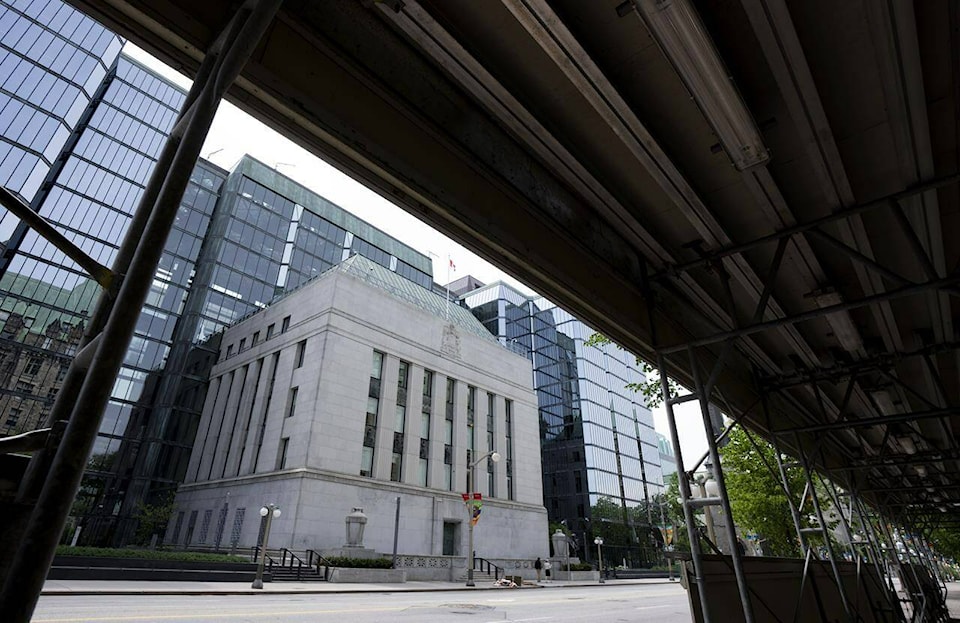~BW Uzelman
The Bank of Canada held interest rates steady at 5% on September 6. Economists are cautious in their predictions for future rates, but are broadly optimistic.
Rising mortgage rates are impacting increasing numbers of Canadians. But Benjamon Tal, deputy chief economist of CIBC informs that a large number of mortgage and other household debt holders will not be impacted in 2023. His report reads, 91¬„¡ƒ ”∆µúOut of the total household debt of $2.7 trillion, close to $650 billion (24 per cent) face actual increase in interest payment this year.91¬„¡ƒ ”∆µù These debt holders and others, no doubt, want an answer to two questions: When is the Bank done hiking interest rates? When will they start cutting rates? Back to that in a bit.
Economist Jim Stanford argues that the Bank has only one job 91¬„¡ƒ ”∆µì to control inflation. The Director of the Centre for Future Work, labels it, 91¬„¡ƒ ”∆µúthe Bank of Canada91¬„¡ƒ ”∆µôs one-dimensional mission91¬„¡ƒ ”∆µù. That is a limited view of its role. The Monetary Policy Framework, an agreement between the Bank and the government, does stress, 91¬„¡ƒ ”∆µúthe primary objective of monetary policy is to maintain low, stable inflation over time91¬„¡ƒ ”∆µù, but also notes, 91¬„¡ƒ ”∆µúMonetary policy should continue to support maximum sustainable employment91¬„¡ƒ ”∆µ¶.91¬„¡ƒ ”∆µù Stanford91¬„¡ƒ ”∆µôs narrow view of the Bank91¬„¡ƒ ”∆µôs role appears to stoke his fear that the Bank may well continue to hike rates.
The Bank91¬„¡ƒ ”∆µôs economic analysis is much broader than simply examining the headline rate of inflation and its favoured core measures of inflation. It also conducts analyses of the labour market, the strength of the economy (GDP) and much more. Its September 6 press release says, 91¬„¡ƒ ”∆µúIn particular, we will be evaluating whether the evolution of excess demand, inflation expectations, wage growth and corporate pricing behaviour are consistent with achieving the 2% inflation target.91¬„¡ƒ ”∆µù The Bank examines and interprets trends across the economy before determining appropriate monetary policy.
Unsurprisingly, the Bank leaves considerable doubt as to whether it will raise rates further. The press release notes that the economy has 91¬„¡ƒ ”∆µúslowed sharply91¬„¡ƒ ”∆µù in the second quarter, with output contracting by 0.2%, which is necessary to relieve price pressure. The release details weaker consumption growth, reduced housing activity and a lessening of the tightness in the labour market, along with continuing wage growth of 4%-5%. The Bank concludes that excess demand is diminishing. This is largely positive, sustaining the BoC91¬„¡ƒ ”∆µôs September decision to hold overnight rate at 5%.
Then comes the bad news, 91¬„¡ƒ ”∆µúRecent CPI data indicate that inflationary pressures remain broad-based.91¬„¡ƒ ”∆µù Inflation increased to 3.3% in July, and with recent gas price increases, the Bank expects the rate to remain elevated in the near term before reducing course. Causing further concern, the Bank91¬„¡ƒ ”∆µôs core measures of inflation remain at 3.5%. Of course, the usual statement of determination follows, 91¬„¡ƒ ”∆µúThe Bank remains resolute in its commitment to restoring price stability for Canadians.91¬„¡ƒ ”∆µù All in all, it is a mixed message: Excess demand is moderating, but inflationary pressures remain.
The next day, however, the Governor of the BoC, Tiff Macklem, managed to sound more optimistic. He allowed, 91¬„¡ƒ ”∆µúMonetary policy is working, and inflation is coming down. But we still have some way to go to restore price stability. With past interest rate increases still working their way through the economy, monetary policy may be sufficiently restrictive to restore price stability.91¬„¡ƒ ”∆µù Macklem added that if they have to, they will raise rates again, but they don91¬„¡ƒ ”∆µôt want the rate to be higher than necessary.
Many economists think the Bank won91¬„¡ƒ ”∆µôt have to raise rates again because excess demand has been wrung out of the economy. Stephen Brown of Capital Economics noted, 91¬„¡ƒ ”∆µúWith demand quickly shifting from excessive to deficient, and given our expectation that two CPI releases before the Bank91¬„¡ƒ ”∆µôs next meeting will show an easing of core inflation pressures, there will be little need for the bank to hike any further.91¬„¡ƒ ”∆µù
Charles St-Arnault of Alberta Central was not so certain. He said further rate increases this year are unlikely, but cannot be ruled out. Douglas Porter of BMO Financials was more confident, 91¬„¡ƒ ”∆µúunless growth rebounds in Q3 91¬„¡ƒ ”∆µì which we doubt 91¬„¡ƒ ”∆µì the BoC is likely done with rate hikes.91¬„¡ƒ ”∆µù
Brown, went further, 91¬„¡ƒ ”∆µúWith recession risks rising and labour market conditions loosening, we continue to think that the bank91¬„¡ƒ ”∆µôs next move will be a rate cut, in early 2024.91¬„¡ƒ ”∆µù Brown was amongst the most optimistic of the experts, but cautious optimists predominate.
The BoC91¬„¡ƒ ”∆µôs next move may indeed be a cut 91¬„¡ƒ ”∆µì not necessarily in the first quarter of next year 91¬„¡ƒ ”∆µì but plausibly within the first two or three quarters. That said, unequivocal forecasts are a risky undertaking. Economists won91¬„¡ƒ ”∆µôt go there, at least not now.
bruce
Bruce W Uzelman
I attended the University of Saskatchewan in Saskatoon.I obtained a Bachelor of Arts, Advanced with majors in Economics and Political Science in 1982.
I have maintained a healthy interest in politics throughout my adult years, and wish to put that and my research skills to work as a political columnist.
Contact: urbangeneral@shaw.ca
Like us on and follow us on .



